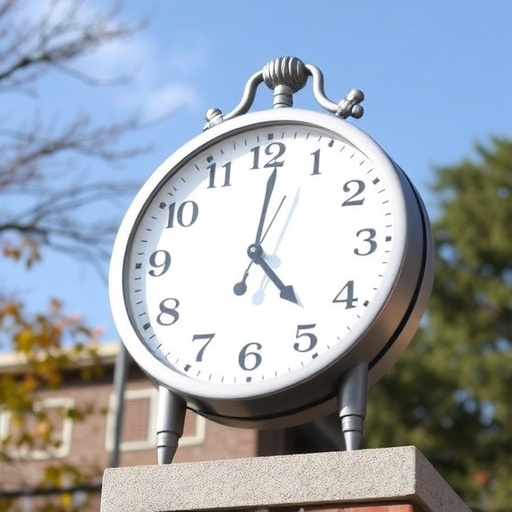Each spring and fall, millions of Americans engage in the ritual of adjusting their clocks for daylight saving time, a practice that not only disrupts daily routines but has been linked with immediate and longer-lasting health consequences. While the acute loss of an hour’s sleep during the spring shift has been shown to increase instances of heart attacks and fatal traffic accidents, recent research suggests that the ramifications extend far beyond these short-term events, potentially shaping nationwide health patterns in profound ways.
A pioneering study conducted by researchers at Stanford Medicine delves deeply into how different timekeeping strategies—permanent standard time, permanent daylight saving time, and the current biannual clock changes—impact the body’s internal clock, or circadian rhythm, and consequently affect long-term health outcomes. The circadian rhythm, an intrinsic biological timer approximating a 24-hour cycle, orchestrates a host of physiological processes from hormone production to metabolism and immune function. Disruptions to this rhythm have been increasingly implicated in various chronic conditions, calling into question the ubiquity of seasonal time shifts.
According to the researchers’ findings, published in the prestigious Proceedings of the National Academy of Sciences, the current pattern of switching clocks twice per year is the least beneficial from the standpoint of circadian alignment and public health. Through detailed modeling that accounts for regional variations in light exposure, as well as demographic characteristics, the team concludes that adopting a permanent time standard—especially permanent standard time—would significantly reduce the burden on people’s biological clocks and yield measurable health benefits.
The crux of the research lies in translating light exposure patterns, shaped by the timing of sunrise and sunset under different time policies, into a metric the researchers call “circadian burden.” This measure quantifies how much an individual’s natural circadian cycle must adjust daily to stay synchronized with the 24-hour solar day. Since human circadian rhythms are naturally slightly longer than 24 hours—approximately 24 hours and 12 minutes on average—timely light exposure is essential to reset the clock each day. Morning light acts to advance the circadian phase, effectively speeding up the clock and helping it align, while evening light delays it.
Their sophisticated mathematical models demonstrated that permanent standard time, which maximizes morning light exposure, imposes the lowest circadian burden for the majority of the population. This finding lends empirical weight to longstanding propositions from sleep and medical organizations that advocate for year-round standard time, arguing that early morning light has uniquely restorative effects on circadian health. Conversely, permanent daylight saving time, which shifts daylight to later hours in the evening, ranks second in circadian benefits but carries less advantage overall.
Interestingly, the study reveals a nuanced picture regarding individual differences. Approximately 15% of people, known as morning larks, possess circadian cycles naturally shorter than 24 hours. For these individuals, increased evening light provided by permanent daylight saving time can synchronize their internal clocks more effectively, lowering their circadian burden. This complexity highlights the challenge of designing public policies that fit diverse biological rhythms within the population.
Beyond circadian modeling, the research team took an innovative step by integrating their circadian data with county-level health statistics from the Centers for Disease Control and Prevention. They specifically examined conditions linked to circadian disruption, including obesity, stroke, diabetes, coronary heart disease, depression, cancer, arthritis, and chronic obstructive pulmonary disease. Their results reveal that permanent standard time could prevent an estimated 300,000 strokes and reduce the prevalence of obesity by 2.6 million cases annually across the U.S. Permanent daylight saving time would achieve roughly two-thirds of these benefits.
Of note, the models showed no significant change in diseases like arthritis, which lack established connections to circadian misalignment, reinforcing the specificity of circadian-mediated health impacts. These findings make a compelling case for reevaluating seasonal clock changes not just as an inconvenience, but as a significant public health concern with tangible long-term effects.
Despite the robustness of their modeling, the authors caution that their work is not the definitive conclusion on the subject. Their simulations made simplifying assumptions about human behavior and light exposure—such as regular sleep-wake schedules from 10 p.m. to 7 a.m. and consistent outdoor light exposure—but real-world scenarios often diverge due to indoor lifestyles, irregular schedules, and various environmental factors like weather and geography. For example, although regions like California offer abundant sunshine, people reportedly spend less than 5% of their day outdoors, limiting natural light’s capacity to entrain circadian rhythms.
The researchers also emphasize that choosing a particular time policy simply defines which clock hours correspond with daylight; it does not alter the fundamental solar cycle or increase total daylight hours during winter months. The immutable celestial mechanics that govern sunrise and sunset remain unchanged regardless of human timekeeping decisions, imposing bound limits on what can be achieved through clock adjustments alone.
This study represents a major advance toward data-driven policymaking about time standards, providing empirical backing where previously only theory and speculation prevailed. However, the authors acknowledge the multidimensional nature of time policy decisions, which intersect with economic, social, and cultural factors not addressed in their circadian-centered analysis. They advocate for interdisciplinary studies to weigh these competing considerations holistically.
In sum, this compelling research highlights the hidden health costs of biannual clock changes while providing a scientifically grounded path forward: embracing permanent standard time to foster healthier circadian rhythms and reduce the burden of diseases tied to circadian misalignment. As society grapples with proposals to eliminate clock switching, these findings offer a crucial piece of evidence that could steer future legislative and public health debates toward more circadian-friendly timekeeping.
Subject of Research: People
Article Title: Circadian-Informed Modeling Predicts Regional Variation in Obesity and Stroke Outcomes Under Different Permanent U.S. Time Policies
News Publication Date: 15-Sep-2025
Web References: https://profiles.stanford.edu/jamie-zeitzer, https://profiles.stanford.edu/lara-weed, https://med.stanford.edu/
References: Proceedings of the National Academy of Sciences
Keywords: Sleep, Circadian Rhythms, Obesity, Stroke, Time Policy, Daylight Saving Time, Public Health




